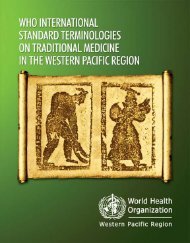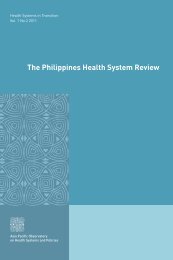Download pdf, 989kb - WHO Western Pacific Region - World Health ...
Download pdf, 989kb - WHO Western Pacific Region - World Health ...
Download pdf, 989kb - WHO Western Pacific Region - World Health ...
Create successful ePaper yourself
Turn your PDF publications into a flip-book with our unique Google optimized e-Paper software.
A Review of Literature and Projects 2005<br />
The distribution of young people in<br />
urban and rural areas from 1995 to<br />
2000 is shown in Figure 5 (10-19 years)<br />
and Figure 6 (20-24 years). There were<br />
more younger adolescents in rural areas<br />
than in urban, but the opposite was true<br />
for older adolescents, who are more<br />
likely to move to towns for higher<br />
education and employment.<br />
The findings on adolescent demography<br />
with respect to the above variables are<br />
useful in formulating further actions to<br />
improve adolescents’ sexual and<br />
reproductive health.<br />
3.1.2. Age at first marriage<br />
The proportion of young people ever<br />
married declined for both males and<br />
females aged 15-24 years between<br />
1970 and 1991 (Figure 7). Age at first<br />
marriage is used as a measure of entry<br />
into sexual activity for both boys and<br />
girls, as well as exposure to risk of<br />
pregnancy and childbirth for girls.<br />
Besides the biological aspect, marriage<br />
also has significant social and economic<br />
repercussions. Marriage includes formal<br />
Figure 6: Distribution by urban-rural areas and gender for the 20-24 age group<br />
Source: Vital statistics Malaysia 2000. Department of Statistics.<br />
21

















